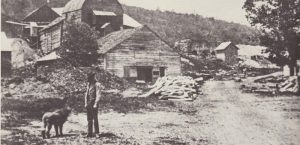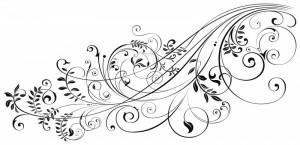We are here to provide resources to those who need them. Here is the contact information for RAINN (Rape, Abuse & Incest National Network), the nation’s largest anti-sexual violence organization
- Call 800.656.HOPE (4673) to be connected with a trained staff member from a sexual assault service provider in your area.
- When you call 800.656.HOPE (4673), you’ll be routed to a local RAINN affiliate organization based on the first six digits of your phone number. Cell phone callers have the option to enter the ZIP code of their current location to more accurately locate the nearest sexual assault service provider.
And now, on to the books:

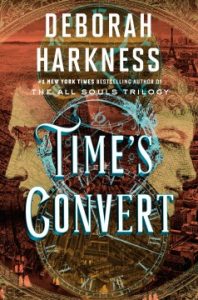 Time’s Converts: Deborah Harkness, author of the beloved All Souls Trilogy brings another time-hopping paranormal love story that is sure to delight her legions of fans. On the battlefields of the American Revolution, Matthew de Clermont meets Marcus MacNeil, a young surgeon from Massachusetts, during a moment of political awakening when it seems that the world is on the brink of a brighter future. When Matthew offers him a chance at immortality and a new life free from the restraints of his puritanical upbringing, Marcus seizes the opportunity to become a vampire. But his transformation is not an easy one and the ancient traditions and responsibilities of the de Clermont family clash with Marcus’s deeply held beliefs in liberty, equality, and brotherhood. Fast-forward to contemporary Paris, where Phoebe Taylor–the young employee at Sotheby’s with whom Marcus has fallen in love–is about to embark on her own journey to immortality. Though the modernized version of the process at first seems uncomplicated, the couple discovers that the challenges facing a human who wishes to be a vampire are no less formidable than they were in the eighteenth century. The shadows that Marcus believed he’d escaped centuries ago may return to haunt them both–forever. A historian herself, Harkness imbues her books with a memorable view of the past and its intersections with the present in a way that Booklist hailed in its review, saying “Effortlessly sweeping across time and continents . . . Harkness replaces the captivating Matthew and Diana dynamic with a passionate new love story.”
Time’s Converts: Deborah Harkness, author of the beloved All Souls Trilogy brings another time-hopping paranormal love story that is sure to delight her legions of fans. On the battlefields of the American Revolution, Matthew de Clermont meets Marcus MacNeil, a young surgeon from Massachusetts, during a moment of political awakening when it seems that the world is on the brink of a brighter future. When Matthew offers him a chance at immortality and a new life free from the restraints of his puritanical upbringing, Marcus seizes the opportunity to become a vampire. But his transformation is not an easy one and the ancient traditions and responsibilities of the de Clermont family clash with Marcus’s deeply held beliefs in liberty, equality, and brotherhood. Fast-forward to contemporary Paris, where Phoebe Taylor–the young employee at Sotheby’s with whom Marcus has fallen in love–is about to embark on her own journey to immortality. Though the modernized version of the process at first seems uncomplicated, the couple discovers that the challenges facing a human who wishes to be a vampire are no less formidable than they were in the eighteenth century. The shadows that Marcus believed he’d escaped centuries ago may return to haunt them both–forever. A historian herself, Harkness imbues her books with a memorable view of the past and its intersections with the present in a way that Booklist hailed in its review, saying “Effortlessly sweeping across time and continents . . . Harkness replaces the captivating Matthew and Diana dynamic with a passionate new love story.”
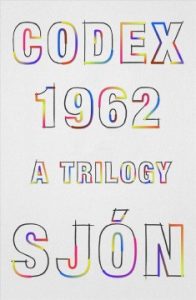 CoDex 1962: Icelandic author and Oscar-nominated songwriter Sjón has earned a global reputation for his utterly unique stories, and now his most famous trilogy of books (outside the English-speaking world) is available in an English translation. Josef Löwe, the narrator of this tale, was born at precisely the same moment as Sjón himself. Josef’s story, however, stretches back decades in the form of Leo Löwe―a Jewish fugitive during World War II who has an affair with a maid in a German inn; together, they form a baby from a piece of clay. In the second story, Löwe arrives in Iceland with the clay-baby inside a hatbox, only to be embroiled in a murder mystery―but by the end of the volume, his clay son has come to life. And in the final volume, set in present-day Reykjavík, Josef’s story becomes science fiction as he crosses paths with the outlandish CEO of a biotech company (based closely on reality) who brings the story of genetics and genesis full circle. This is a story that is part folklore, part traditional epic, part sci-fi, part mystery, and all together a unique story that Sjón’s fans and new comers alike will savor. Kirkus Reviews gave this book a starred review, noting “In this beguiling, surpassingly eccentric triptych, Icelandic novelist Sjón takes on, in turn, romance (classic, not Gothic), mystery, and science fiction to examine how people parse themselves into little camps and try to make their way through this harsh world . . . Sjón’s work is unlike anything else in contemporary fiction. Strange―but stunning.”
CoDex 1962: Icelandic author and Oscar-nominated songwriter Sjón has earned a global reputation for his utterly unique stories, and now his most famous trilogy of books (outside the English-speaking world) is available in an English translation. Josef Löwe, the narrator of this tale, was born at precisely the same moment as Sjón himself. Josef’s story, however, stretches back decades in the form of Leo Löwe―a Jewish fugitive during World War II who has an affair with a maid in a German inn; together, they form a baby from a piece of clay. In the second story, Löwe arrives in Iceland with the clay-baby inside a hatbox, only to be embroiled in a murder mystery―but by the end of the volume, his clay son has come to life. And in the final volume, set in present-day Reykjavík, Josef’s story becomes science fiction as he crosses paths with the outlandish CEO of a biotech company (based closely on reality) who brings the story of genetics and genesis full circle. This is a story that is part folklore, part traditional epic, part sci-fi, part mystery, and all together a unique story that Sjón’s fans and new comers alike will savor. Kirkus Reviews gave this book a starred review, noting “In this beguiling, surpassingly eccentric triptych, Icelandic novelist Sjón takes on, in turn, romance (classic, not Gothic), mystery, and science fiction to examine how people parse themselves into little camps and try to make their way through this harsh world . . . Sjón’s work is unlike anything else in contemporary fiction. Strange―but stunning.”
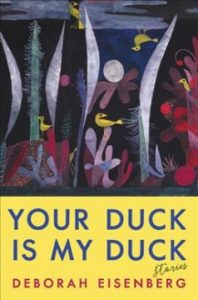 Your Duck is My Duck: Deborah Eisenberg is a gifted short-story writer, and that talent shines through in this new collection. In Eisenberg’s world(s), the forces of money, sex, and power cannot be escaped, and the force of history, whether confronted or denied, cannot be evaded. These forces wind through a varied and engrossing set of tales: a tormented woman whose face determines her destiny; a group of film actors shocked to read a book about their past; a privileged young man who unexpectedly falls into a love affair with a human rights worker caught up in an all-consuming quest that he doesn’t understand. The result is a collection that earned a starred review from Publisher’s Weekly, who called it …”superlative and entertaining…Eisenberg is funny, grim, biting, and wise, but always with a light touch and always in the service of worlds that extend far beyond the page. A virtuoso at rendering the flickering gestures by which people simultaneously hide and reveal themselves, Eisenberg is an undisputed master of the short story.”
Your Duck is My Duck: Deborah Eisenberg is a gifted short-story writer, and that talent shines through in this new collection. In Eisenberg’s world(s), the forces of money, sex, and power cannot be escaped, and the force of history, whether confronted or denied, cannot be evaded. These forces wind through a varied and engrossing set of tales: a tormented woman whose face determines her destiny; a group of film actors shocked to read a book about their past; a privileged young man who unexpectedly falls into a love affair with a human rights worker caught up in an all-consuming quest that he doesn’t understand. The result is a collection that earned a starred review from Publisher’s Weekly, who called it …”superlative and entertaining…Eisenberg is funny, grim, biting, and wise, but always with a light touch and always in the service of worlds that extend far beyond the page. A virtuoso at rendering the flickering gestures by which people simultaneously hide and reveal themselves, Eisenberg is an undisputed master of the short story.”
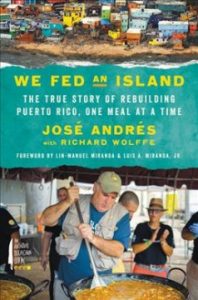 We Fed an Island: The True Story of Rebuilding Puerto Rico, One Meal at a Time: Chef José Andrés arrived in Puerto Rico four days after Hurricane Maria ripped through the island. The economy was destroyed and for most people there was no clean water, no food, no power, no gas, and no way to communicate with the outside world. Andrés addressed the humanitarian crisis the only way he knew how: by feeding people, one hot meal at a time. From serving sancocho with his friend José Enrique at Enrique’s ravaged restaurant in San Juan to eventually cooking 100,000 meals a day at more than a dozen kitchens across the island, Andrés and his team fed hundreds of thousands of people, including with massive paellas made to serve thousands of people alone.. At the same time, they also confronted a crisis with deep roots, as well as the broken and wasteful system that helps keep some of the biggest charities and NGOs in business. Based on Andrés’s insider’s take as well as on meetings, messages, and conversations he had while in Puerto Rico, this book movingly describes how a network of community kitchens activated real change and tells an extraordinary story of hope in the face of disasters both natural and man-made, offering suggestions for how to address a crisis like this in the future. This book earned another starred review from Kirkus Reviews, who cheered “…The author’s passion to help people is palpable . . . His actions should be the basis for future work by FEMA and other humanitarian agencies . . . A passionate and courageous story that should be required reading for anyone involved in disaster response.”
We Fed an Island: The True Story of Rebuilding Puerto Rico, One Meal at a Time: Chef José Andrés arrived in Puerto Rico four days after Hurricane Maria ripped through the island. The economy was destroyed and for most people there was no clean water, no food, no power, no gas, and no way to communicate with the outside world. Andrés addressed the humanitarian crisis the only way he knew how: by feeding people, one hot meal at a time. From serving sancocho with his friend José Enrique at Enrique’s ravaged restaurant in San Juan to eventually cooking 100,000 meals a day at more than a dozen kitchens across the island, Andrés and his team fed hundreds of thousands of people, including with massive paellas made to serve thousands of people alone.. At the same time, they also confronted a crisis with deep roots, as well as the broken and wasteful system that helps keep some of the biggest charities and NGOs in business. Based on Andrés’s insider’s take as well as on meetings, messages, and conversations he had while in Puerto Rico, this book movingly describes how a network of community kitchens activated real change and tells an extraordinary story of hope in the face of disasters both natural and man-made, offering suggestions for how to address a crisis like this in the future. This book earned another starred review from Kirkus Reviews, who cheered “…The author’s passion to help people is palpable . . . His actions should be the basis for future work by FEMA and other humanitarian agencies . . . A passionate and courageous story that should be required reading for anyone involved in disaster response.”
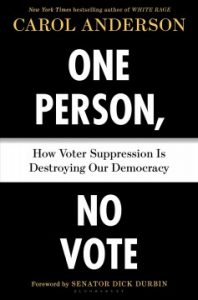 One Person, No Vote: How Voter Suppression Is Destroying Our Democracy: In this timely and insightful work, Carol Anderson considers the ramifications and results of the 2013 Supreme Court ruling Shelby County v. Holder, also known as the Shelby Ruling, eviscerated the Voting Rights Act of 1965, allowing districts with a demonstrated history of racial discrimination to change voting requirements without approval from the Department of Justice. Focusing on the aftermath of Shelby, Anderson follows the astonishing story of government-dictated racial discrimination unfolding before our very eyes as more and more states adopt voter suppression laws. In gripping, enlightening detail she explains how voter suppression works, from photo ID requirements to gerrymandering to poll closures, as well as the efforts of grassroots organizations and individuals to ensure the basic rights of democratic citizenship. Anderson’s book was named a Pick of the Month by Library Journal, who wrote in their review, “In White Rage, a New York Times best seller that won the National Book Critics Circle Award,Emory professor Anderson chronicled efforts since 1865 to block the advancement of African Americans. Here she concentrates on efforts to curtail the African American vote since the 2013 Shelby ruling gutted the Voting Rights Act of 1965. Anderson considers both consequences–e.g., photo ID requirements, poll closures–and means of redress.”
One Person, No Vote: How Voter Suppression Is Destroying Our Democracy: In this timely and insightful work, Carol Anderson considers the ramifications and results of the 2013 Supreme Court ruling Shelby County v. Holder, also known as the Shelby Ruling, eviscerated the Voting Rights Act of 1965, allowing districts with a demonstrated history of racial discrimination to change voting requirements without approval from the Department of Justice. Focusing on the aftermath of Shelby, Anderson follows the astonishing story of government-dictated racial discrimination unfolding before our very eyes as more and more states adopt voter suppression laws. In gripping, enlightening detail she explains how voter suppression works, from photo ID requirements to gerrymandering to poll closures, as well as the efforts of grassroots organizations and individuals to ensure the basic rights of democratic citizenship. Anderson’s book was named a Pick of the Month by Library Journal, who wrote in their review, “In White Rage, a New York Times best seller that won the National Book Critics Circle Award,Emory professor Anderson chronicled efforts since 1865 to block the advancement of African Americans. Here she concentrates on efforts to curtail the African American vote since the 2013 Shelby ruling gutted the Voting Rights Act of 1965. Anderson considers both consequences–e.g., photo ID requirements, poll closures–and means of redress.”
Until next week, beloved patrons, happy reading.

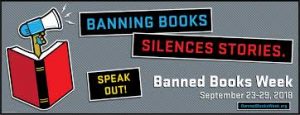
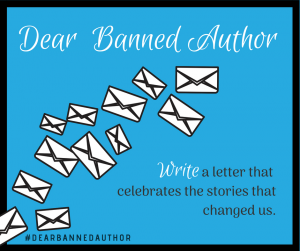

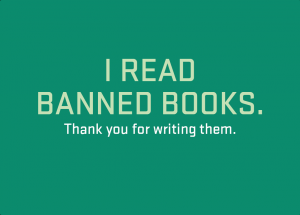
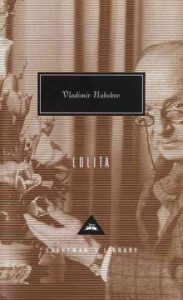
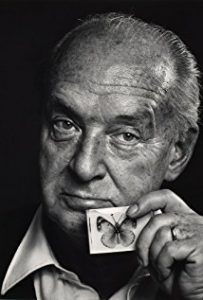 Nabokov’s 1956 letter is to his friend and fellow scholar
Nabokov’s 1956 letter is to his friend and fellow scholar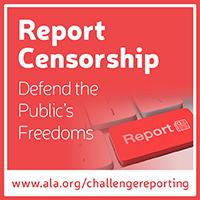 We here at the Library are big fans of Banned Books Week, and constant supporters of your right to read whatever you so desire. As such, you can look forward to enjoying some themed blog posts this week, starting with the ALA’s list of most challenged books of 2017, and the reasons for these challenges. The ALA Office for Intellectual Freedom tracked 354 challenges to library, school and university materials in 2017. Of the 416 books challenged or banned in 2017, these titles were the most challenged:
We here at the Library are big fans of Banned Books Week, and constant supporters of your right to read whatever you so desire. As such, you can look forward to enjoying some themed blog posts this week, starting with the ALA’s list of most challenged books of 2017, and the reasons for these challenges. The ALA Office for Intellectual Freedom tracked 354 challenges to library, school and university materials in 2017. Of the 416 books challenged or banned in 2017, these titles were the most challenged:
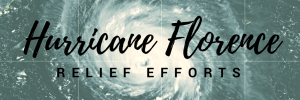
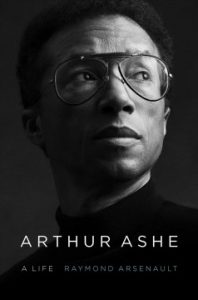
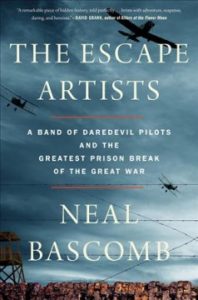
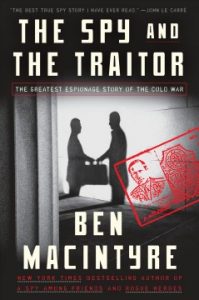
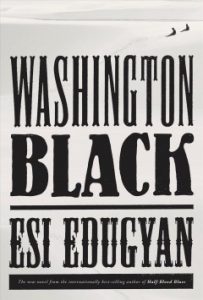
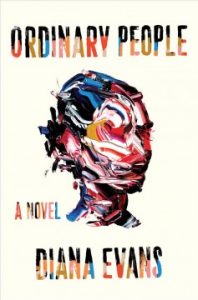


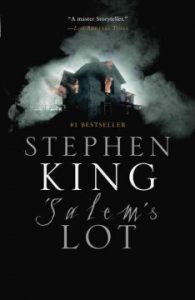
 I also really liked that King used his study of a small town to talk about the ways in which secrets moved and circulated, and about the impact of evil. Not just the big evils (although Big Evils abound in this book), but the petty kinds of evil: laziness, greed, selfishness, chauvinism. If this book reinforces a real-world message, it is that those kind of small evils permit more small evils, and those build and build into something truly fearful. Larry Crockett, for example, is a shady, lazy, sexist real estate agent who rents out the Marsten House (see an imagined image on the left), even though he knows in his gut that the man renting it is seriously bad news. But he is also earning a very fat commission on the transaction, so he looks the other way–and allows the vampires to enter ‘Salem’s Lot. We learn, eventually, about how the town turned away from the things that scared or disturbed them about the Marsten House…and how that permitted the evil inside it to fester. I appreciated the ways that King discussed the grief and pain that these evils caused, from the loss of a child to the anguish of marital rape (and I also give him a world a credit for calling it ‘marital rape’ in 1975).
I also really liked that King used his study of a small town to talk about the ways in which secrets moved and circulated, and about the impact of evil. Not just the big evils (although Big Evils abound in this book), but the petty kinds of evil: laziness, greed, selfishness, chauvinism. If this book reinforces a real-world message, it is that those kind of small evils permit more small evils, and those build and build into something truly fearful. Larry Crockett, for example, is a shady, lazy, sexist real estate agent who rents out the Marsten House (see an imagined image on the left), even though he knows in his gut that the man renting it is seriously bad news. But he is also earning a very fat commission on the transaction, so he looks the other way–and allows the vampires to enter ‘Salem’s Lot. We learn, eventually, about how the town turned away from the things that scared or disturbed them about the Marsten House…and how that permitted the evil inside it to fester. I appreciated the ways that King discussed the grief and pain that these evils caused, from the loss of a child to the anguish of marital rape (and I also give him a world a credit for calling it ‘marital rape’ in 1975).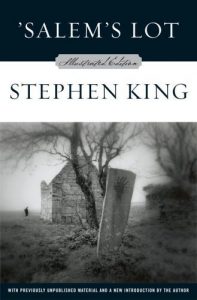 Oh, right, and I also loved the vampires. That should go without saying. But if you can’t tell, while this book scared me, I loved it too much to be scared of it. Instead, I read it every year as fall begins. And every year, I find something else to love. Right after reading it the first time, I traveled to Belfast for a research trip. Belfast wasn’t the best of areas to be around that time, as the trauma of the Troubles was still very real. While I was there, I listened to the audiobook of ‘Salem’s Lot, and appreciated anew how well King plays on our very human fears of being alone and isolated. It was a sensational that was as real in Belfast at the turn of the century as it was in the ghost town of Momson, Vermont, which “dried up and blew away” in 1923 (according to the novel).
Oh, right, and I also loved the vampires. That should go without saying. But if you can’t tell, while this book scared me, I loved it too much to be scared of it. Instead, I read it every year as fall begins. And every year, I find something else to love. Right after reading it the first time, I traveled to Belfast for a research trip. Belfast wasn’t the best of areas to be around that time, as the trauma of the Troubles was still very real. While I was there, I listened to the audiobook of ‘Salem’s Lot, and appreciated anew how well King plays on our very human fears of being alone and isolated. It was a sensational that was as real in Belfast at the turn of the century as it was in the ghost town of Momson, Vermont, which “dried up and blew away” in 1923 (according to the novel).